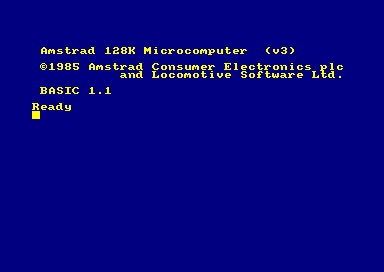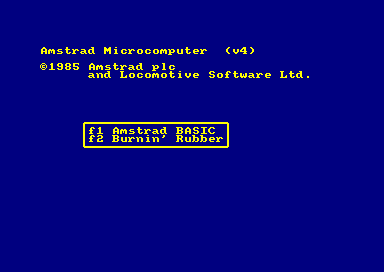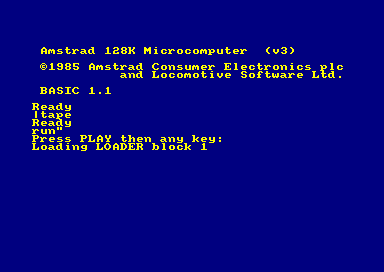Difference between revisions of "A guide to running software on a real Amstrad CPC/CPC Plus computer"
Malespiaut (Talk | contribs) (→Loading disc software using "|CPM": Formatting clean-up) |
Malespiaut (Talk | contribs) (Removing years old placeholders and missing images to clarify reading.) |
||
| Line 25: | Line 25: | ||
Ready | Ready | ||
</pre> | </pre> | ||
| − | |||
You can now follow the instructions to use the cassette or disc software. | You can now follow the instructions to use the cassette or disc software. | ||
| − | |||
== Loading cassette software on a real Amstrad CPC/CPC+ system == | == Loading cassette software on a real Amstrad CPC/CPC+ system == | ||
| Line 51: | Line 49: | ||
[[File:Cpc6128r.gif|center|frame|Commands to load from cassette on a CPC with a disc interface]] | [[File:Cpc6128r.gif|center|frame|Commands to load from cassette on a CPC with a disc interface]] | ||
| − | |||
| − | |||
# Press the PLAY button on the cassette player. | # Press the PLAY button on the cassette player. | ||
| Line 100: | Line 96: | ||
If you typed <code>CAT</code> then you will also see the size of each file. | If you typed <code>CAT</code> then you will also see the size of each file. | ||
In both cases the amount of free space is also displayed. | In both cases the amount of free space is also displayed. | ||
| − | |||
| − | |||
| − | |||
'''Note:''' In case of a “Read fail” error, please try the loading method using the <code>|CPM</code> command. (see the instructions below) | '''Note:''' In case of a “Read fail” error, please try the loading method using the <code>|CPM</code> command. (see the instructions below) | ||
| Line 109: | Line 102: | ||
If there is a single file, then this should be run by typing <code>RUN"<filename></code> replacing <code><filename></code> with the name of the file. | If there is a single file, then this should be run by typing <code>RUN"<filename></code> replacing <code><filename></code> with the name of the file. | ||
(e.g. <code>RUN"disc.bin</code>) | (e.g. <code>RUN"disc.bin</code>) | ||
| − | |||
| − | |||
'''Note:''' If the file has a <code>.BAS</code>, <code>.BIN</code> or <code>. </code> (3 spaces) as an extension then you can omit it. | '''Note:''' If the file has a <code>.BAS</code>, <code>.BIN</code> or <code>. </code> (3 spaces) as an extension then you can omit it. | ||
| Line 131: | Line 122: | ||
In this example, the file <code>ZAPTBALL.BAS</code> should be run. | In this example, the file <code>ZAPTBALL.BAS</code> should be run. | ||
| − | |||
| − | |||
If the computer crashes, resets or “PROGRAM LOAD FAILED” is displayed, then choose another file and try again. | If the computer crashes, resets or “PROGRAM LOAD FAILED” is displayed, then choose another file and try again. | ||
| Line 145: | Line 134: | ||
Retry, Ignore or Cancel? | Retry, Ignore or Cancel? | ||
</pre> | </pre> | ||
| − | |||
| − | |||
==== Read fail ==== | ==== Read fail ==== | ||
| Line 155: | Line 142: | ||
Retry, Ignore or Cancel? | Retry, Ignore or Cancel? | ||
</pre> | </pre> | ||
| − | |||
| − | |||
== Loading disc software using <code>|CPM</code> == | == Loading disc software using <code>|CPM</code> == | ||
| Line 166: | Line 151: | ||
'''Note:''' The <code>|</code> symbol can be obtained by pressing SHIFT and “@” (at) together on the Amstrad keyboard. | '''Note:''' The <code>|</code> symbol can be obtained by pressing SHIFT and “@” (at) together on the Amstrad keyboard. | ||
| − | |||
| − | |||
The program loads and run! | The program loads and run! | ||
| Line 188: | Line 171: | ||
Retry, Ignore or Cancel? | Retry, Ignore or Cancel? | ||
</pre> | </pre> | ||
| − | |||
| − | |||
These errors show that the command has failed and that the program can't be started using the <code>|CPM</code> command. | These errors show that the command has failed and that the program can't be started using the <code>|CPM</code> command. | ||
| Line 199: | Line 180: | ||
Retry, Ignore or Cancel? | Retry, Ignore or Cancel? | ||
</pre> | </pre> | ||
| − | |||
| − | |||
This error shows that the command has failed and the program can't be started using the <code>|CPM</code> command. | This error shows that the command has failed and the program can't be started using the <code>|CPM</code> command. | ||
Revision as of 03:37, 18 April 2024
A guide to running software on a real Amstrad CPC/CPC+ computer
Contents
Restarting an Amstrad CPC to load a cassette or disc software
Amstrad CPC464, CPC664, CPC472 or CPC6128
- Switch off the computer and switch it on again.
The computer will show the startup message and there will be a “Ready” prompt.
You can now follow the instructions to use cassette or disc software.
Amstrad CPC+
- Switch the computer off.
- Insert the system cartridge (which contains the game “Burnin' Rubber” and “Locomotive BASIC”).
- Switch on the computer.
A menu will then be displayed with two options “f1 Amstrad BASIC” and “f2 Burnin Rubber”.
- Press f1 to select “Amstrad BASIC”.
- The screen will clear and then display:
BASIC 1.1 Ready
You can now follow the instructions to use the cassette or disc software.
Loading cassette software on a real Amstrad CPC/CPC+ system
- Restart the computer.
- Insert the cassette into the cassette player.
Note: On a CPC464 or CPC464+ system you must insert the cassette into the internal cassette player.
If you are using a CPC with a disc interface you will need to type |TAPE and then press the large ENTER key (CPC464) or RETURN key (CPC6128, CPC464+,CPC6128+).
Note:
- The
|symbol can be obtained by pressing SHIFT and “@” (at) together on the Amstrad keyboard. - The CPC664, CPC6128 and CPC6128+ have a disc interface built-in, and this command must be used to enter cassette mode.
- The CPC464 and CPC464+ have a cassette player built in. If you have a disc interface (Amstrad/Schneider DDI-1 or Vortex) connected you will need to type this command to enter cassette mode. If you do not have a disc interface, you do not need to type this command.
Now type RUN" and then press the large ENTER key (CPC464) or RETURN key (CPC6128, CPC464+,CPC6128+).
Tips:
- On a CPC464 system you can press SHIFT and the small ENTER key (on the keypad) together instead of typing
RUN". - On a CPC464+, CPC6128, or CPC6128+ system you can press SHIFT and ENTER together instead of typing
RUN".
The message Press PLAY then any key: will be displayed.
- Press the PLAY button on the cassette player.
- Press any key on the Amstrad keyboard, and the cassette will start to play.
After a short time you will see the message Loading <filename> block x where <filename> is the filename of the program found and x is the number of the blocks.
Troubleshooting
- If you see the error “Bad command” then make sure you type in
|TAPE. - Try completely rewinding the cassette again and wait. It is possible that the Amstrad missed the first file.
- The cassette may not be made for the Amstrad and won't load.
- The cassette may be damaged and be unusable.
- The cassette may have been inserted on the wrong side.
For each block that is successfully read, the Amstrad will report the block number. When all of the blocks of the file have been loaded, the program will start automatically.
If there is a error, the message Read error a or Read error b will be shown.
If this happens, you can rewind the cassette to the start of the block with the error and try again.
If you have an external cassette recorder, then you can try to adjust the volume. This may make a difference.
Loading disc software on a real Amstrad CPC/CPC+ system
- Restart the computer.
- Insert the disc into the disc drive.
- Type
CATor|DIRand then press the large ENTER key (CPC464) or RETURN key (CPC6128, CPC464+,CPC6128+).
These commands will display a listing (directory) of the files on the disc.
Note:
The | symbol can be obtained by pressing SHIFT and “@” (at) together on the Amstrad keyboard.
A message similar to the following will be displayed:
Drive A: user 0 DISC.BAS 1K 177K free
This is the directory of the files on the disc.
Here you will see the names of each file.
If you typed CAT then you will also see the size of each file.
In both cases the amount of free space is also displayed.
Note: In case of a “Read fail” error, please try the loading method using the |CPM command. (see the instructions below)
The directory shows the list of files on the disc.
If there is a single file, then this should be run by typing RUN"<filename> replacing <filename> with the name of the file.
(e.g. RUN"disc.bin)
Note: If the file has a .BAS, .BIN or . (3 spaces) as an extension then you can omit it.
(e.g. if the file is DISC.BIN you can type RUN"disc instead of RUN"disc.bin)
The disc operating system is not case sensitive, therefore you do not need to type the name exactly as shown.
(i.e. disc.bin is the same as DISC.BIN.)
If there is more than one file, look for a small file with a .BAS, .BIN or . extension.
Drive A: user 0 ZAPTBALL.BAS 4K ZAPTBALL.BI3 14K ZAPTBALL.BI0 2K ZAPTBALL.BI4 11K ZAPTBALL.BI1 13K ZAPTBALL.BI5 8K ZAPTBALL.BI2 8K ZAPTBALL.LEV 8K 112K free Ready
In this example, the file ZAPTBALL.BAS should be run.
If the computer crashes, resets or “PROGRAM LOAD FAILED” is displayed, then choose another file and try again.
Disc reading error messages
Disc missing
This message will be displayed if the disc is not inserted, or the disc is inserted and the drive belt in the disc drive has worn out and needs replacing.
Drive A: disc missing Retry, Ignore or Cancel?
Read fail
This message will be displayed if the directory can't be read or the directory is corrupted. It is possible the disc may not have a directory. In this case try the "|CPM" loading method described below.
Drive A: read fail Retry, Ignore or Cancel?
Loading disc software using |CPM
You should attempt to start a program on a disc using this method if there is a “Read fail” error with the CAT or |DIR commands.
- Restart the computer.
- At the “Ready” prompt, type
|CPMand then press the large ENTER key (CPC464) or RETURN key (CPC6128, CPC464+,CPC6128+).
Note: The | symbol can be obtained by pressing SHIFT and “@” (at) together on the Amstrad keyboard.
The program loads and run!
Disc reading error messages
Read fail
Drive A: read fail Retry, Ignore or Cancel?
If you press the “R” key, then the “read fail” message is repeated.
If you press “I” or “C” keys then the following message is displayed.
Failed to load boot sector Retry, Ignore or Cancel?
These errors show that the command has failed and that the program can't be started using the |CPM command.
Failed to load boot sector
Failed to load boot sector Retry, Ignore or Cancel?
This error shows that the command has failed and the program can't be started using the |CPM command.



